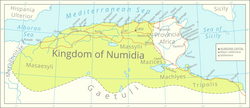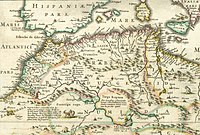Kingdom of Numidia | |||||||||||||||
|---|---|---|---|---|---|---|---|---|---|---|---|---|---|---|---|
| 202 BC–25 BC | |||||||||||||||
|
Numidian coins under Massinissa | |||||||||||||||
 Map of Numidia after the Punic Wars | |||||||||||||||
| Capital | Cirta (today Constantine, Algeria) | ||||||||||||||
| Official languages | Punic[a][2][3][4] | ||||||||||||||
| Common languages | Numidian[b] Latin[c] Greek[d] | ||||||||||||||
| Religion | Numitheism, Punic Religion | ||||||||||||||
| Government | Monarchy | ||||||||||||||
| King | |||||||||||||||
• 202–148 BC | Masinissa | ||||||||||||||
• 148 – 118 BC | Gulussa | ||||||||||||||
• 148–140 BC | Mastanabal | ||||||||||||||
• 118–117 BC | Hiempsal I | ||||||||||||||
• 118–112 BC | Adherbal | ||||||||||||||
• 118–105 BC | Jugurtha | ||||||||||||||
• 105–88 BC | Gauda | ||||||||||||||
• 88–81 BC | Masteabar | ||||||||||||||
• 84–82 BC | Hiarbas II | ||||||||||||||
• 88–60 BC | Hiempsal II | ||||||||||||||
• 60–46 BC | Juba I | ||||||||||||||
• 81–46 BC | Massinissa II | ||||||||||||||
• 44–40 BC | Arabion | ||||||||||||||
| Historical era | Antiquity | ||||||||||||||
• Established | 202 BC | ||||||||||||||
• Annexed by the Roman Empire | 25 BC | ||||||||||||||
| Currency | Numidian Coinage, carthagenian coinage | ||||||||||||||
| |||||||||||||||
| Today part of | |||||||||||||||
| History of Algeria |
|---|
 |
Numidia was the ancient kingdom of the Numidians in northwest Africa, initially comprising the territory that now makes up Algeria,[10] but later expanding across what is today known as Tunisia and Libya. The polity was originally divided between the Massylii state in the east (Capital : Cirta)and the Masaesyli in the west (Capital: Siga).[11] During the Second Punic War (218–201 BC), Masinissa, king of the Massylii, defeated Syphax of the Masaesyli to unify Numidia into the first unified Berber state for Numidians in present-day Algeria.[12] The kingdom began as a sovereign state and an ally of Rome and later alternated between being a Roman province and a Roman client state.
Numidia, at its foundation, was bordered by the Moulouya River to the west,[13] Africa Proconsularis and Cyrenaica to the east.[14][15] the Mediterranean Sea to the north, and the Sahara to the south so that Numidia entirely surrounded Carthage (Appian, Punica, 106) except towards the sea.[16] before Masinissa expanded past the Moulouya and vassalizing Bokkar, and reaching the Atlantic ocean to the west.[17][18][19]
- ^ Quinn, Josephine Crawley; Vella, Nicholas C. (2014-12-04). The Punic Mediterranean. Cambridge University Press. ISBN 978-1-107-05527-8.
- ^ Baldauf, Richard B.; Kaplan, Robert B. (2007-01-01). Language Planning and Policy in Africa. Multilingual Matters. p. 38. ISBN 978-1-84769-011-1.
Numidic kings and elites spoke and used Punic as the official language while peasants spoke Berber. The Carthaginian idiom was in use until the third century CE
- ^ Fage, J. D.; Oliver, Roland Anthony (1975). The Cambridge History of Africa. Cambridge University Press. p. 184. ISBN 978-0-521-21592-3.
Punic was employed as the official language of the Numidian kingdom, as is shown by monumental inscriptions and coin legends. Numidia even became something of a centre of Punic literary culture. In 146 BC the Romans presented to Micipsa the captured library of Carthage, and in the following century, as has been seen, a Numidian king (Hiempsal II) wrote a history of his country in Punic.
- ^ Hoyos, B. Dexter (2015). Mastering the West: Rome and Carthage at War. Oxford University Press. p. 277. ISBN 978-0-19-986010-4.
The Punic language and religion survived the cataclysm too. Many if not most Libyan communities used Punic for official purposes, as did the Numidian kingdom.
- ^ Boutammina, Nas E. (2022-01-06). Le numide, langue populaire de la Berbérie (in French). Books on Demand. ISBN 978-2-322-41710-0.
- ^ Chaker, S. (2008-01-01). "Libyque : écriture et langue". Encyclopédie berbère (in French) (28–29): 4395–4409. doi:10.4000/encyclopedieberbere.344. ISSN 1015-7344. S2CID 161729616.
- ^ Camps, G.; Claudot-Hawad, H.; Chaker, S.; Abrous, D. (1996-08-01). "Écriture". Encyclopédie berbère (in French) (17): 2564–2585. doi:10.4000/encyclopedieberbere.2125. ISSN 1015-7344.
- ^ Hirst, Anthony; Silk, Michael (2017-05-15). Alexandria, Real and Imagined. Routledge. ISBN 978-1-351-95959-9.
- ^ Roller, Duane W. (2004-02-24). The World of Juba II and Kleopatra Selene: Royal Scholarship on Rome's African Frontier. Routledge. ISBN 978-1-134-40296-0.
- ^ "Numidia". Livius. 23 Sep 2020. Retrieved 2 Aug 2024.
- ^ Cite error: The named reference
:3was invoked but never defined (see the help page). - ^ Thomas M. Leonard (2013). Encyclopedia of the Developing World. Routledge. p. 169. ISBN 978-1-135-20508-9.
- ^ Dictionary of Greek and Roman Geography. Retrieved 16 February 2020.
- ^ Cite error: The named reference
:4was invoked but never defined (see the help page). - ^ Cite error: The named reference
:5was invoked but never defined (see the help page). - ^ Cite error: The named reference
:6was invoked but never defined (see the help page). - ^ Cite error: The named reference
:0was invoked but never defined (see the help page). - ^ Cite error: The named reference
:1was invoked but never defined (see the help page). - ^ Cite error: The named reference
:2was invoked but never defined (see the help page).
Cite error: There are <ref group=lower-alpha> tags or {{efn}} templates on this page, but the references will not show without a {{reflist|group=lower-alpha}} template or {{notelist}} template (see the help page).
